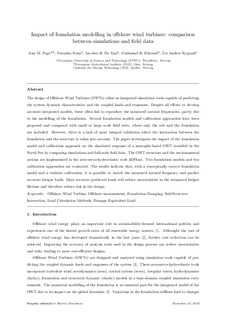Impact of foundation modelling in offshore wind turbines: Comparison between simulations and field data
Page, Ana M.; Næss, Veronika; De Vaal, Jacobus Bernardus; Eiksund, Gudmund Reidar; Nygaard, Tor Anders
Journal article, Peer reviewed
Accepted version
Permanent lenke
http://hdl.handle.net/11250/2583843Utgivelsesdato
2019Metadata
Vis full innførselSamlinger
- NGI articles [1037]
Sammendrag
The design of Offshore Wind Turbines (OWTs) relies on integrated simulation tools capable of predicting the system dynamic characteristics and the coupled loads and responses. Despite allefforts to develop accurate integrated models, these often fail to reproduce the measured naturalfrequencies, partly due to the modelling of the foundation. Several foundation models and ca-libration approaches have been proposed and compared with small or large scale field tests,where only the soil and the foundation are included. However, there is a lack of more integralvalidation where the interaction between the foundation and the structure is taken into account.The paper investigates the impact of the foundation model and calibration approach on the si-mulated response of a monopile-based OWT installed in the North Sea by comparing simulationsand full-scale field data. The OWT structure and the environmental actions are implemented inthe aero-servo-hydro-elastic code 3DFloat. Two foundation models and two calibration ap-proaches are evaluated. The results indicate that, with a conceptually correct foundation modeland a realistic calibration, it is possible to match the measured natural frequency and predictaccurate fatigue loads. More accurate predicted loads will reduce uncertainties in the estimatedfatigue lifetime and therefore reduce risk in the design Impact of foundation modelling in offshore wind turbines: Comparison between simulations and field data
